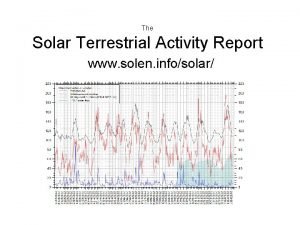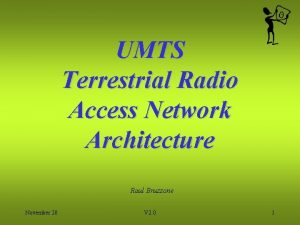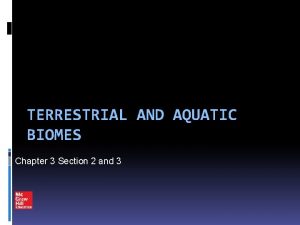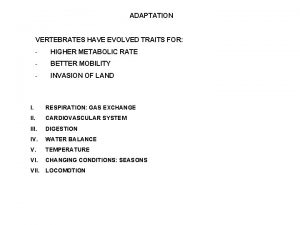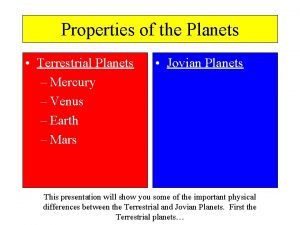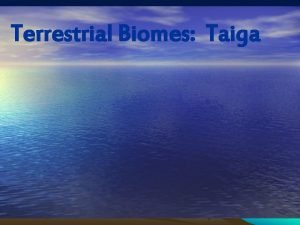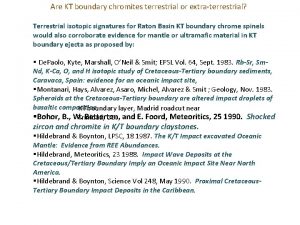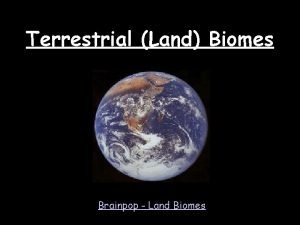TERRESTIAL NAVIGATION TERRESTIAL NAVIGATION Terrestrial navigation is the











- Slides: 11

TERRESTIAL NAVIGATION

TERRESTIAL NAVIGATION • Terrestrial navigation is the method of navigation used by mariners that uses landmarks as reference points, ship's stability, fuel consumption and ship's speed along with tides and currents. • This is the opposite of celestial navigation, which plots positions in relation to the stars.

RADIO WAVES • An electromagnetic wave of a frequency between about 104 and 1011 or 1012 Hz, as used for long-distance communication. • Radio waves are a type of electromagnetic radiation with wavelengths in the electromagnetic spectrum longer than infrared light. Radio waves have frequencies as high as 300 GHz to as low as 3 k. Hz,

RADIO WAVES The various properties of Radio waves are: • • The Velocity of electromagnetic wave in vacuum is 3 × 108 m / s. The existence of medium is not essential for propagation. E. M waves can be polarized. E. M waves are transverse in nature. E. M waves have momentum. There is no deflection on account of magnetic or electric field. They can exhibit diffraction and interference.

PROPAGATION OF RADIO WAVES

ANTENNA • Radio waves are used for fixed and mobile radio communication, broadcasting, radar and other navigation systems, communications satellites, computer networks and innumerable other applications. • In order to receive radio signals, for instance from AM/FM radio stations, a radio antenna must be used. • An antenna is an electrical device which converts electric power into radio waves, and vice versa.

ANTENNA • An antenna consists of an arrangement of metallic conductors, electrically connected to the receiver or transmitter. An oscillating current of electrons forced through the antenna by a transmitter will create an oscillating magnetic field around the antenna elements, while the charge of the electrons also creates an oscillating electric field along the elements.

ANTENNA CHARACTERISTIC • • • Resonant antennas Current and voltage distribution Electrically short antennas Arrays and reflectors Bandwidth Gain Effective area or aperture Field regions Impedance Efficiency Polarization Impedance matching

DIPOLAR ANTENNA • A basic dipole antenna consists of two conductors arranged symmetrically, with one side of the balanced feedline from the transmitter or receiver attached to each. • The most common type, the half-wave dipole, consists of two resonant elements just under a quarter wavelength long. This antenna radiates maximally in directions perpendicular to the antenna's axis, giving it a small directive gain. • Dipoles are typically oriented horizontally in which case they are weakly directional: signals are reasonably well radiated toward or received from all directions with the exception of the direction along the conductor itself; this region is called the antenna blind cone or null.

ANTENNA APERTURE • In antenna theory, antenna aperture, effective area, or receiving cross section is a measure of how effective an antenna is at receiving the power of radio waves. • The aperture is defined as the area, oriented perpendicular to the direction of an incoming radio wave, which would intercept the same amount of power from that wave as is produced by the antenna receiving it. • If an antenna delivers an output power of Po watts to the load connected to its output terminals when irradiated by a uniform field of power density PFD watts per square metre, the antenna's aperture Aeff in square metres is given by: Aeff=Po/PFD

LORAN • LORAN is a long range hyperbolic system of position fixing which measures the time difference between the beginning of master and beginning of secondary pulse. • This system comprises of chains and each chain comprises of one master(M) and usually two to four secondary stations called W, X, Y, Z. • Hyperbolic position can be fixed using time difference and phase difference.
 Terrestrial navigation definition
Terrestrial navigation definition Solar terrestrial activity report
Solar terrestrial activity report A terrestrial food web
A terrestrial food web Umts network architecture
Umts network architecture Events 2022
Events 2022 Consist of many overlapping food chains
Consist of many overlapping food chains Chapter 3 section 2 terrestrial biomes
Chapter 3 section 2 terrestrial biomes Terrestrial life
Terrestrial life Respiration in terrestrial animals
Respiration in terrestrial animals Properties of terrestrial planets
Properties of terrestrial planets Inner terrestrial planets
Inner terrestrial planets What are the inner and outer planets
What are the inner and outer planets

